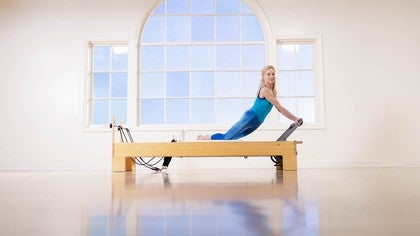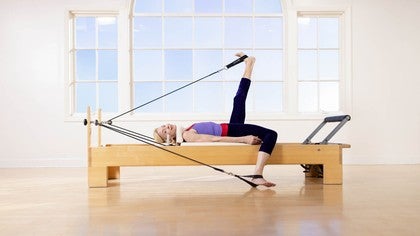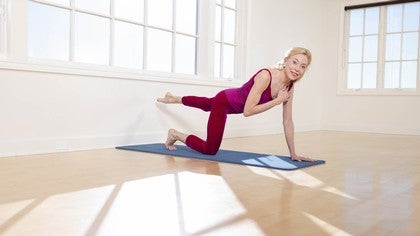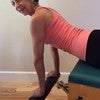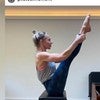Description
Watch this discussion to learn more about circadian rhythm.
About This Video
Transcript
Read Full Transcript
Welcome to articulate reformer for calm focus. We'll start with no springs. Off with the spring and also off with the loops. You can just put the loops on the ground. Come to lie on your back on your mat.
The mat's beside the carriage, and then place the carriage in the middle of the frame so that when you lie on your back supported by the mat, you can have your heels a comfortable distance apart and away from the frame. While you're here, your pelvis is steady on the mat while you slide the carriage towards the foot bar, and slide the carriage towards the risers. As you do this, your thighs, your knees will tilt. Sliding the carriage towards the risers, your knees go towards the foot bar. And sliding the carriage towards the foot bar, your knees go to the risers.
Steady your sacrum on the mat and there will be a spiral of your femurs, a spiral of your legs, and that has a subtle, but I hope pleasant effect for you in terms of the tugging on the tissues, the glide between your lower ribs and your pelvis. Now continue the rhythm that you've set up and each leg gets its own turn. This will accentuate the internal rotation from your hip joint and the external rotation spiral. Two more slides of these. Continue the rhythm.
The new heel awaits and it gets its own turn. It's always some form of amazement to feel like, "Wow, my two sides are so different." Yes they are. They have always been and they always will be, and we'll always be trying to do something about it. Now you plant both feet on the carriage and move a little closer to the frame so that the backs of your calves and the backs of your heels are supported on the carriage. Press the backs of your calves into the carriage and lift your pelvis up.
So yes, you're in a suspended pelvis bridge. Now your pelvis leads towards the foot bar, and then your pelvis leads to the risers. So now, it's a lateral translation of your pelvis. You have options with your arms. You can keep your arms down.
You could hold onto your bent elbow forearms in front of your low ribs. You could bend your elbows and plant your palms on the ground next to your ears. As you shift towards the foot bar, the foot bar's sitting bone aims towards the frame. And then when you shift to the risers, your riser's sitting bone aims towards the frame. Side to side here.
Now add rotation. Navel and all toes go to the risers, navel and all toes go to the foot bar. So it's a rotation, a bridging with rotation. Take your arms straight up to the ceiling, palms together, fingers interlaced, pelvis leads the way, and then carriage follows. Last two and last one.
Now roll to either side. Make your way up from here and let's change now to the new side. So walk around and prepare for quadruped. We'll keep no springs on the carriage, no springs at all. You'll have your knees on the mat, and we'll have the carriage all the way to the foot bar end.
Elbows in line with your shoulders. Slide the carriage to the risers and slide so far that your foot bar knee comes off the ground. And then slide to the foot bar and hover the other knee. Exhale to slide, inhale to hover. Slide and hover.
We have two more of these with the light from your chest bone between your bent elbow forearms. Stay at this end, the foot bar end, and change your bent to your hands so that your hands aim towards the far shoulder rest. On this diagonal now, shift towards the riser. So your close knee comes off the mat, and then hover. Shift, lift, shift, hover.
Shift, lift, shift, hover. We have two more of these. And again. Swivel so that your hands are towards the foot bar and your feet are on the opposite diagonal. Shift to the slide to the risers.
One knee comes off and the other knee lifts. Exhale to slide, inhale to hover. We have two more of these. Now all three orientations will occur from the riser end. Bring the carriage all the way to the riser end of the frame.
Plant your bent elbow forearms. You have options with your palms. If your palms are up, that will help to widen across your collarbones and slide your shoulder blades away from your neck and ears. Another option is to have your palms towards each other. Slide towards the risers.
Hover the, sorry slide towards the foot bar, hover the riser knee, and lift. Slide, hover. Slide, hover. And again, turning your pelvis around the head of your femurs. Now swivel both hands towards the riser end of the carriage and slide on this diagonal.
Exhale to slide, inhale to hover. And one more of these. Change diagonals. Each of these different ground forces through your bent elbow, forearms, and through your knees, each of these puts different forces, different vectors through your whole torso and particularly through your abdominal area. Let's change now to standing in the well.
When you stand in the well, you'll need one spring on the carriage. So you choose the spring that's preferable for you. I prefer a yellow spring. Some others of you will prefer a blue, others even are red. Position yourself so that when your knees are bent, your sitting bones are towards the risers and the heels of your hands are forward on the shoulder rest.
Elbows fairly extended. As you extend your knees with straight elbow arms, pull the carriage back towards you. Inhale to slide the carriage towards the foot bar, exhale, extend both knees. Breathe in to spread your sitting bones wide, and exhale. We have two more of these.
For the moment, have the motion occur at your hip joints and at your knees and shoulders rather than undulating your spine. We'll get there, but not just at the moment. Now swivel so that all toes aim on one diagonal, and then you put both hands on the shoulder rest where your heels are pointing. So your torso and your head going where your toes are pointing, your sitting bone's back behind, your hands on the shoulder rest closer to your heels. Extend both knees and bend both.
Breathing in, and exhale to slide the carriage forward. Breathing in. We have two more of these. Steering your knees forward over your second, third toes. Swivel.
Now your head is aiming where your toes are pointing, and both hands go to the shoulder rest closer to your heel. Inhalation as you pull the carriage towards you and exhale to slide away. Breathing in, and exhaling. Rising to the occasion, and then getting even longer. Sliding both shoulder blades in the direction of their own sitting bones and both shoulder blades slide towards the opposite hip pockets.
Return to your parallel stance, facing the foot bar and cross your forearms. Note which forearm you have on top first because soon, will have another forearm on top. With your straight elbows crossed, as you exhale, draw the carriage towards your shins and bend. I've given you different cues for breathing, so why don't I come clean and discuss which one has an advantage? Inhalation and exhale to go with the spring or exhalation will give you a little bit more engagement, activation of tissues, and inhalation will go with the spring's tugging.
Now change. The underneath arm comes on top. Inhalation, and exhale. Breathing in and exhale or change it up. Exhale to bring the carriage towards your shins, inhale to go forward, exhale, and inhalation Time now for something completely different.
Let's do single leg footwork. To get ready for single leg footwork, first of all, you'll put the loops around the shoulder rests or the shoulder posts as it suits you so you can reach them easily later. Next, you'll place the foot bar in the orientation that's best for your single leg footwork. And next, you'll choose your springs. So the springs that are optimal for your single leg.
Come to lie on your back. Headrest can be up or down, cushion as it suits you for your head, your neck, place the front of your heels in line with your sitting bones, and in each variation, each leg gets three turns. Here we go. Pressing out and in. From your heel to your sitting bone and beyond.
Keep the rhythm going and change to the new side. Drawing your knee up towards your hip joint. Change legs. It's external rotation spiral for which you're well prepared. Continue your rhythm with the external rotation spiral on the new side.
Internal rotation now. Steering your knee over your second, third toes, an internal rotation spiral of your whole femur, and change end. Now all toes will go to the outside. So you're in abduction and external rotation. Change.
Abduction and external rotation. Change. Abduction and internal rotation. Change. Abduction and in internal rotation.
Now you cross the midline into external rotation. This is where it takes some mighty fancy dancing to get there from here. Abduction and external rotation, and then you cross the midline into internal rotation. I know, I set the rules and then I break them, right? I said we're going to keep the rhythm going.
So there you have it. Many single leg footwork on your heel, and now something similar on the sole of your toes, the ball of your foot on your metatarsal hands. One and two and three. Change into parallel. Two and three.
External rotation with your foot aligned with its same side sitting bone. Change, external rotation on the new side. Internal rotation. Both legs are spiraling towards the midline. Change, internal rotation.
Now it's wide to the side on the widest part of the foot bar in external rotation. Keep the rhythm going. External rotation and abduction. External, I mean abduction and internal rotation. Now it's time to cross the midline.
The soles of your toes on the bar in turning out, crossing the midline and turnout. Cross the midline and turnout. Cross the midline and turn in, spiraling towards the midline, the new midline, especially when you're crossing over to the other side. So that particular series of variations requires focus, and one has to stay calm in order to keep the rhythm. Let's prepare now for the bent elbow arm arcs and circles.
For this, you'll choose the springs that are optimal for you. I'm going to go with a red spring on the bottom deck, a red spring on the hook. And you feel free to choose the springs that are going to allow you to have the best shoulder girdle organization and a feeling of accomplishment. How about that? Come to lie on your back, and you'll take the short loops around the palms of your hands.
Your bent elbows are in contact with the ground with the carriage and your fingers are outstretched. You can have your knees towards your torso. You could choose and ankle to cross or you could extend your knees and take your feet towards the ceiling as you prefer. Now your elbows are a distance away from the sides of your ribs that allow your shoulder blades to be at ease, well-organized on the carriage. Wiggle your fingers, and as you exhale, have the idea that the little finger side of your hand pulls down towards the carriage, and then leads around in the external rotation quarter circle from your shoulder.
Now lead down with your fourth finger. Fourth finger leads the way. Exhale down and open. Third finger leads the way down and around. Exhale down and inhale open, and your index finger, the first finger leads the way.
As you might expect, the new direction awaits. The little finger sides of your hands, they lead the way around. Continue these arm quarter circles with your fourth finger carving through space. Now your third finger, and then your index finger. And we'll do this again, but you have the idea of all fingers are leading now.
All fingers press down and open, and down and open. Reverse direction. Around and in, and around and in. We'll put these loops down now because it's time for feet in the straps. However, you will need to change the springs for that.
Choose the springs that are optimal for feet in the loops. I suggest two red springs, and you adjust according to your preferences. You have options. You can put the short loop on the sole of your midfoot or the long loop. When you use the short loop or the short cords, that tends to make the spring resistance feel stronger 'cause you have a different lever length.
We have walking on the ceiling in parallel, keeping your pelvis fairly steady on the carriage. This is in articulation at your hip joints, alternating sides. We have a total of four repetitions here. External rotation. As the carriage slides, you bend one knee, bringing your heel behind your straight leg knee.
Your bent knee heel goes behind the straight leg knee. Now in internal rotation. Both legs are in internal rotation, pulling down with a straight leg. The straight leg pulls down and match it with the other foot. All toes towards the right.
All toes and both knees, they are aiming right while you keep the back of your left pelvis, the back of your left ilium on the carriage. Now all toes and both knees, they aim left. Now you have internal rotation with abduction. Your legs separate from the midline. One knee is bent.
The straight leg inner thigh pulls in. Alternate sides. Two more of these over the edge of the frame. Time now for leg circles with feet in straps. Parallel, external rotation, internal rotation, all toes right, all toes left.
We will go up and open, being very intentional about staying in parallel initially. That way, there's a contrast when you spiral open into external rotation and you keep your rhythm with an internal rotation spiral, aiming your knees and toes inward towards the midline. All toes, both knees to the right with the back of your left pelvis in contact with the carriage, and change. All toes, both knees to the left with the back of your right pelvis in contact with the carriage. Return to parallel and change the new direction.
Exhale down, around, and open with the intention of staying in parallel throughout the range of motion. And now, it's time for spiraling into external rotation. Change to internal rotation. All toes, both knees right. And all toes, both knees left.
Prepare now for the straight elbow arm circles. For this, I would imagine you ought to change the springs. Certainly, I should. Choose the spring that's going to be best for your straight elbow arm circles. I'll go with a red.
You choose what you prefer. When you come to lie on your back, the headrest will be down unless you prefer to have a cushion underneath your head. Your straight elbow palms are across the short loops and you have your knees to your torso. Ankle crossed or not, legs outstretched or not. Leading with the little finger side of your hand, exhale, draw down, open and around.
Down and open. Now your fourth finger draws down and open, and down and open. And then your third finger leads the way and your second finger. As your second finger draws down, your collarbones are wide. Reverse direction.
Your little finger comes towards your side, up and open. Carving around, up and open. And your fourth finger carves around. Your middle finger leads the way, and your index finger has a turn. Now prior to the next combination for these bent elbow and straight elbow arm circles, I would just like to share with the group to mention that the reason for suggesting each finger takes a turn is that your, the architecture, the design of your neuro myofascial system is such that there are fascial continuities connective tissue continuities between each finger and your your wings.
Yes, your shoulder blades, your scapula, your ribs. So when you give each finger a turn to lead, that activates a particular focus of the fascial system towards your ribs, your thoracic spine, and your shoulder blades. Now you have both bent elbow forearms on the carriage. All hands to the right, and circle down with your little finger, and open, down, around. All hands right, and then left.
Middle fingers, hands right, hands left. And this is a spiral of internal rotation and index finger now and external rotation at your glenohumeral joints. Reverse. Hands left, right, and open. Left, right, and up.
Fourth finger, down, around, and open. Third finger, middle finger, and index finger takes a turn. Both straight elbow hands up to the ceiling, both arms to the right, steady with your sacrum, and both arms left. This is much more demanding for your torso organization. Third finger leads the way, and index finger leads.
Reverse the direction. Little fingers left, right, center. Left, right center. Fourth fingers left, right, center. Bringing some of your attention to the movement of your scapula with respect to your thorax, and some attention to which finger is aiming where.
So there you have it. Many variations of your arm arcs. Elbows bent and elbow straight. It's time to finish up now with standing in the well with standing in the well for spine undulations. Let's change the springs.
I suggest a yellow or a fairly light spring. We won't need the loops. So the loops can go on the ground, and then you'll come to stand in the well. I think bring the headrest up so you might have a little bit more excursion with the carriage. Sitting bones are towards the risers.
Bending your knees, spreading your sitting bones, and straight elbow hands are forward on the shoulder rest. As you exhale, curl your tailbone under, spine flexion. And then as you go forward, spine extension. Moving your pelvis around the head of your femurs. We have two more of these.
Undulating flexion and extension. Flexion and extension. Extension and flexion. Two more of these. Lift your tailbone, lift your chest bone, lift your gaze.
Swivel on your feet. All toes aim diagonally right, both hands are on the left side so that your hands are on the shoulder rest closer to your heels. Flexion and extension. Under and out. Two more of these.
Reverse the orientation spine extension, changing the order of undulation, steering your knees well forward over your second, third toes. Swivel to the new side. Both hands change to the shoulder rest closer to your heels. Pelvis moves, rotates, and then rotates over the head of your femurs. Flexion and extension.
Flexion and extension. Reverse, lift your chest bone, tuck your tailbone under. Gaze up, and down. Twice more looking up underneath your eyebrows, down behind the cheekbones of your face. Crossing your bent, crossing your straight elbow arms.
Exhale, spine flexion. Inhale, forward. Reverse direction. Up and down, and up and down. The underneath arm comes on top.
Let go of the shoulder rests, come all the way up to vertical. Grateful to have made it this far. Thank you so much for joining me at Pilates. Anytime. I'll look forward to seeing you soon with calm focus. Bye now.
The Teacher's Corner: Spike Protein Induced Conditions
Comments
You need to be a subscriber to post a comment.
Please Log In or Create an Account to start your free trial.
